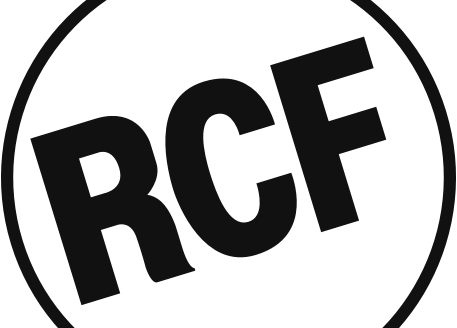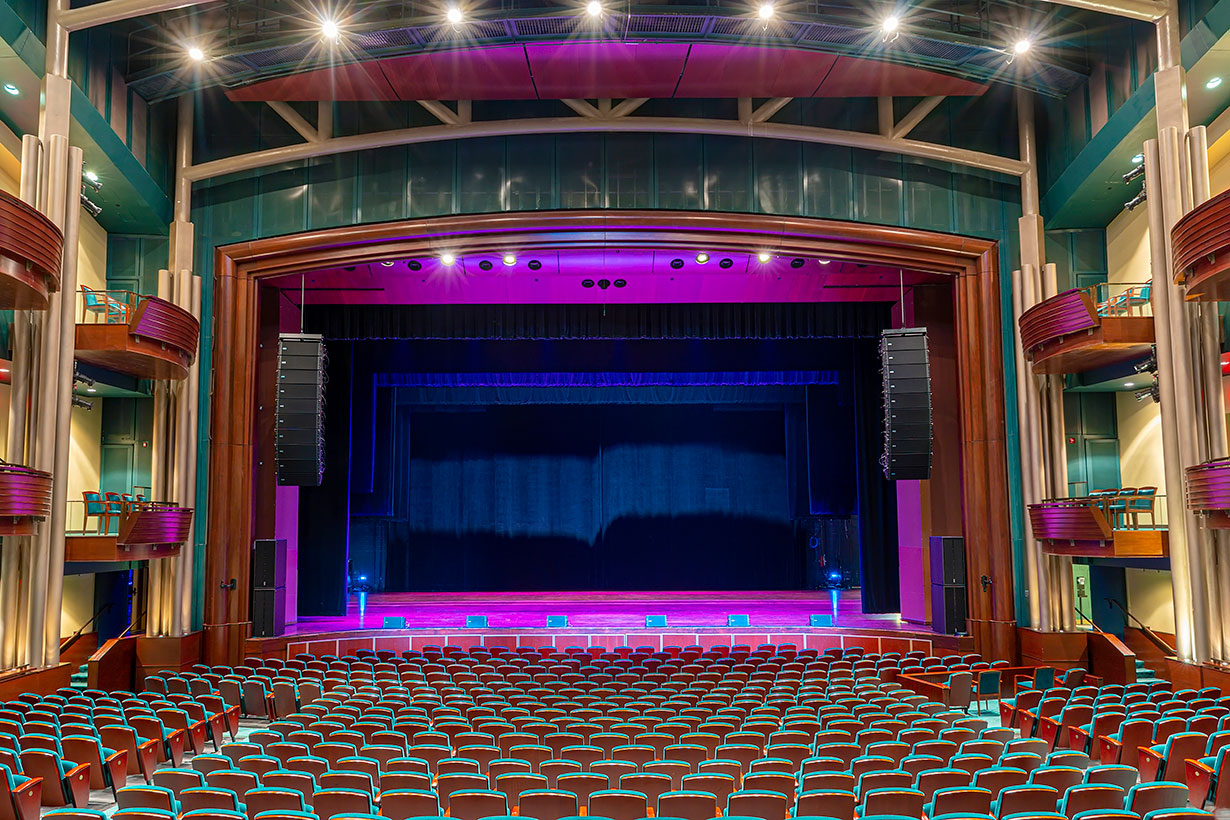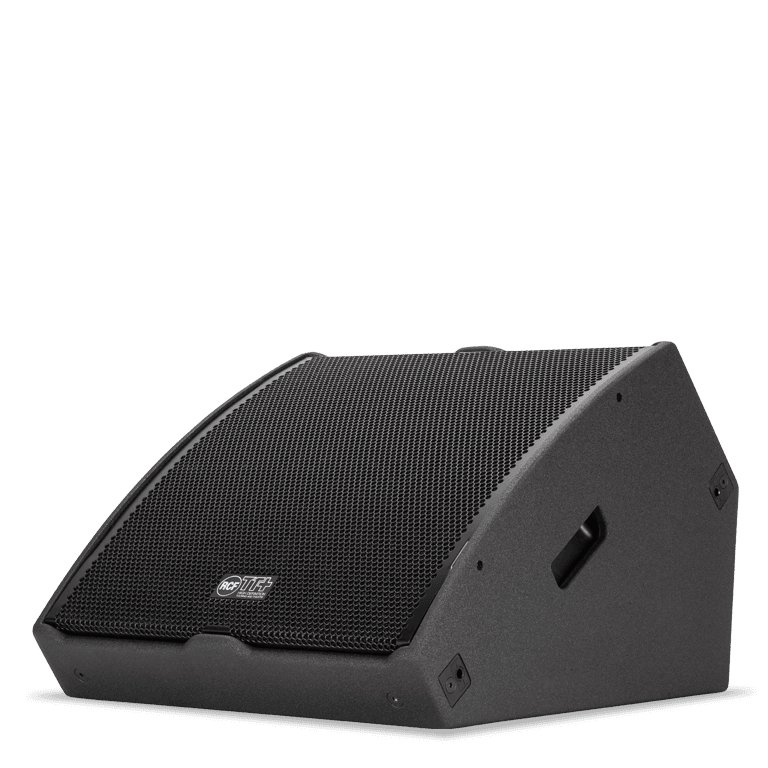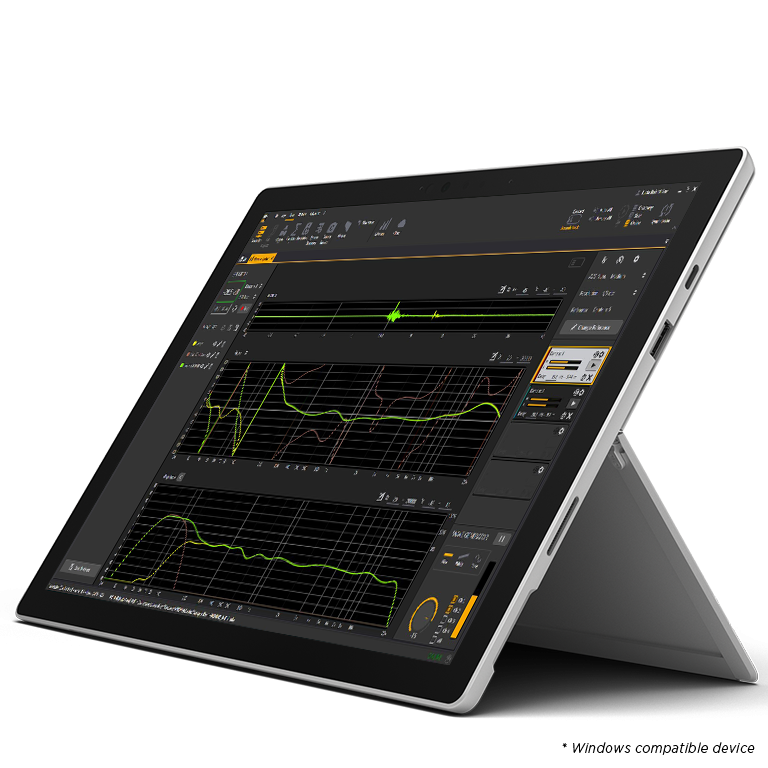NATURAL EVOLUTION
Audio transforms the Ferguson Center for the Arts
Located in Christopher Newport University in Newport News, Virginia, the Ferguson Center for the Arts is a world-class venue that has been visited by more than two million people since its opening in 2004. The facility plays host to an eclectic mix of talent ranging from headlining acts like Tony Bennett, Wynton Marsalis, Jay Leno, and Ziggy Marley all the way to Broadway shows, symphonies, student productions, lectures, and more.
The center has always valued keeping pace with the latest technology has to offer. “In some ways it seems we are always in a state of upgrading something somewhere,” says Eric “Ketch” Kelly, the facility’s audio engineer. Kelly began a touring sound career with Bob Marley and the Wailers, Peter Tosh, Jimmy Cliff, and others. When Kelly arrived at Ferguson the main 1,700-seat Diamonstein Concert Hall had no main PA. A piecemealed assortment of gear was all that was available. “It was really just for speech reinforcement and had limited coverage. We would rent PA for all our visits by touring acts, and as those fees piled up, I was able to convince management to purchase a system of our own that would serve both our in-house needs and those of our visitors.”
From the roots of this first PA the system evolved as time progressed, continuing with the purchase of 20 TTL 31-A loudspeakers from RCF along with a pair of TTS 56-A 2 x 21” subs. Following the addition of another pair of TTS 56-As, and then the turning of the calendar to December 2021, the main room was upgraded to 24 RDNet-equipped, three-way TTL 55-A cabinets from RCF deployed at a rate of 12 per side. With 3500 watt, four-way amplification found onboard each of these active line array modules, the high-powered boxes are additionally loaded with six neodymium transducers (three 1.5” compression drivers, a 10” midrange, and pair of 12” woofers) and 96 KHz of 32-bit DSP processing.
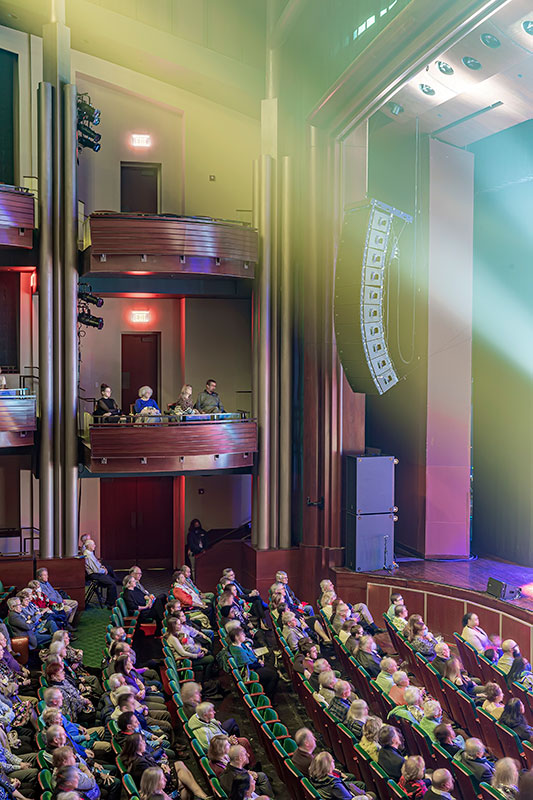
“We went with the RCF products based upon sound quality,” Kelly says, “and the unmatched support they had given us over the years.” Later Kelly brought in six of RCF’s TTL 36-AS active subwoofers. Equipped with a pair of 18-inch neodymium drivers sporting 4.5” voicecoils, like the full-range TTL 55-A boxes flown left-and-right, these subs are outfitted with their own onboard power (4,000 watts each), 96 KHz/32-bit processing, and RDNet networking. Stacked at stage level two high per side in the house’s standard configuration, three can be added per side as required to create a cardioid setup or used in other placements with legacy subs culled from the Ferguson Center’s extensive gear inventory to enhance forward addition and rearward subtraction via end-firing or gradient configurations with multiple boxes.
As time passed with the house’s original PA still in place, Kelly found that many touring acts found it a bit undersized. “What impressed me about the TTL 55-A cabinets was that they are double-12s,” he relates. “As a result, even at low volumes you can feel the impact of our new, upgraded system. My take has always been that when you have ample headroom and power at hand it tends to keep engineers mixing at quieter levels, and that’s a valuable attribute in a theatre of our size. These double-12s are mounted in a clam shell band-pass loading configuration as well, and that makes the box actually not much ‘bigger’ horizontally than most others it competes with. Bottom line, the visual impact isn’t huge at all, but the physical impact is.”
Combining modeling and prediction done with Rational Acoustics’ Smaart v8 and a FLUX:: Pure Analyzer, as well as good old-fashioned critical listening techniques, Kelly, with the aid of RCF’s Tarik Solangi and Oscar Mora, tuned the upgraded system while using RDNet to examine and shape, characteristics, and performance of the RCF boxes individually and in groups. Used in conjunction with RDNet, FiRPHASE, RCF’s proprietary finite impulse response (FIR) filtering, utilized an accurate measurement of each loudspeaker’s phase to correct both phase and amplitude (if necessary) while taking into account the physical characteristics of the transducers as well as the resonances and cancellations produced by the cabinets themselves.
“FiRPHASE makes a difference,” Kelly reports. “Especially when you consider the number of guest engineers that pass through here. Everyone mixes differently, and every show requires different mixing. Now it’s nice to be able to hand an engineer a tablet and have them be able to use the filters instead of doing a lot of EQing when they can.”
“The thing that really differentiates this PA from our previous one is that it’s very linear,” Kelly says on a final note. “It doesn’t matter if you’re running it down quiet around 65 dB or jumping up north of 100. There is a nice consistency, increased power, vocal clarity, and remarkable imaging. Having the double 12s, the 10, and the horn in the TTL 55-As translates into an added richness we lacked before. The sound is very fluid, very rich, and as I noted earlier, has impact even at low volumes, and then well beyond. You can feel the air moving when a kick drum hits, along with a thump in your chest. This kind of performance isn’t typical of the smaller drivers found in many other systems. I’ve enjoyed the positive remarks of everyone who comes through here from teachers doing lectures to some of the best touring engineers around.”
“We are undergoing part of a natural, continuous evolution that strives to transform the way audiences hear what comes from the stage in a fashion that keeps getting better and better.”
Kelly provides a standard—or what he calls benchmark tuning for all his guests. He keeps that simple then provides a tablet for accessing either RDNet or the room’s Lake LM26 and LM44 processing, which remains part of the equation for signal routing. Whatever tunings are set, a touch of a button returns the rig to a default setting at the end of the night.
Onstage monitoring currently relies upon a combination of RCF’s TT 20-CXA 2 x 8” and TT 45-CXA 2 x 10” wedges. IEMs from Shure include six PSM 1000 P10T transmitters and 13 P10T beltpacks. Drawing once again from its large collection of in-house inventory, Kelly’s input list is peppered with a variety of mics including a DPA d:facto II, Shure KSM8, KSM9, and SM58 transducers, and an assortment of DPA lavalier and headset mics.
“I have used DPA microphones for a long time,” Kelly notes. “Given the origins of our newly-updated PA, I don’t know if I can claim any influence over RCF’s decision to buy the company at this moment, but I gladly will after a few drinks at a bar.”
Wireless includes four holdover channels of Shure Axient Analog using four handheld transmitters and four beltpacks, eight channels of ULX-D that can be used with any combination of eight available handheld transmitters or eight beltpacks, and four channels of Axient Digital accessible via four handheld transmitters and a pair of beltpacks.
While developing his wireless blueprint Kelly brought in engineers from Shure who scanned all three of Ferguson’s theatres. Declaring the smallest “probably one of the safest RF rooms in the world,” the main hall didn’t fare as well according to their analysis and remains a challenge based not only on the large amount of broadcast interference in the area, but also the outsized military presence within a 30-mile radius that includes Langley Air Force Base, Naval Air Station Oceana, and Naval Station Norfolk.
“I would never suggest that someone in a military aircraft might be in a backseat testing their jamming equipment overhead right during a show,” Kelly says, still expressing his jocular side. “But sometimes you just might believe it. Shure’s Wireless Workbench is vital to our RF efforts, and as far as antennas go we have a paddle located downstage and an omnidirectional upstage. This combination provides high gain and a high surface area in terms of reception, and both are located 15 feet in the air while still keeping sight lines clear.”
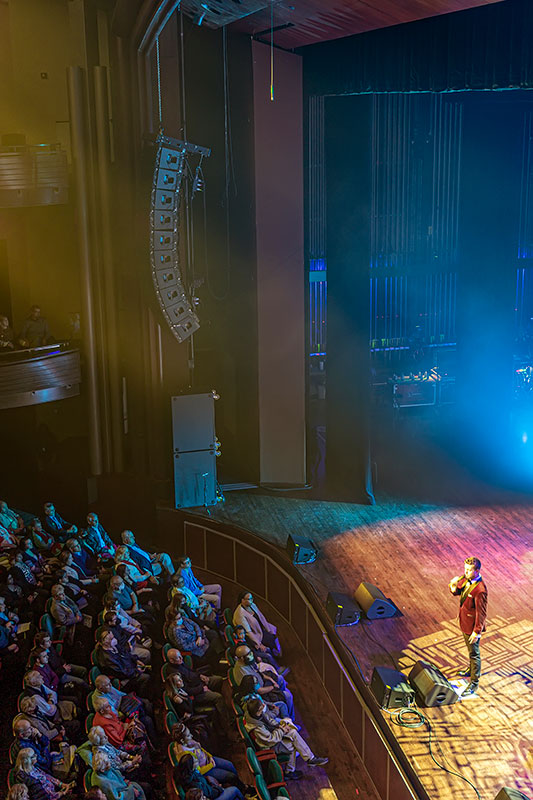
As with other aspects of the system, consoles were chosen for the theatre with the idea of providing something for everyone and every application. Generally used at front of house, a 64 x 32 Solid State Logic L200 Plus is joined by a 64 x 32 Yamaha CL5, a 48 x 32 Avid VENUE Mix Rack (the oldest among the group), and a recently added Allen & Heath SQ-5.
POSITIVE ASSOCIATION
Prior to the recently completed sonic upgrade that introduced a new PA based around RCF’s TTL 55-A line array modules at the Ferguson Center for the Arts, the venue logged a little over ten years with its predecessor, another RCF rig using smaller two-way loudspeakers that were also products of the Italian company’s TTL lineup.
“When Ketch called me shortly before COVID hit and said he wanted to move up to a bigger system in the theatre, I was more than happy to go do a demo of our 55 box,” recalls RCF USA VP of Sales and Marketing Tarik Solangi. “It was one of those they listened to it and loved it presentations, and then all of a sudden the pandemic shut everything down and we were left in limbo.”
Needless to say, when the virus finally began losing its grip and the world began to unmask, the Ferguson Center picked up the pieces of its upgrade plan and moved forward, sealing the deal and further cementing a relationship with RCF now in its second decade.
The Ferguson Center’s current collection of TTL 55-A components was tuned by RCF’s Oscar Mora to be deployed in a standard left-right/sub configuration using the manufacturer’s RDNet network and control platform, which provides for array and zone grouping, monitoring, and an ability to make high-pass, EQ, gain, and delay adjustments on individual loudspeakers. Along with the theatre’s standard configuration, Mora also created presets within the RDNet software enabling the PA to be quickly changed into an end-fire configuration or gradient end-fire arrangement.
“While we’ve become well-known for our HDL Series loudspeakers,” Solangi adds, “this installation shines a spotlight on our flagship TT+ Series, which is expressly designed for live concerts, sports events, speech reinforcement, performing arts centers like Ferguson, and other high-end applications. We have some interesting plans to expand the product group in the very near future, but for now we couldn’t be happier to continue our relationship with everyone here at the Ferguson Center. It’s a positive association that anyone in this industry would be rightly proud of.”
Related products
TT 20-CXA
ACTIVE TWO-WAY HIGH DEFINITION MONITOR
- 131 dB SPL Max
- 1000W RMS, two-way Class-D amplifier
- 90° x 70° constant directivity coverage
- Multifuncional cabinet with symmetrical transducers’ design
TTL 31-A II
ACTIVE COMPACT LINE ARRAY MODULE
- 750 W switching amplifiers
- Wide, constant directivity coverage angle
- 4 high power neodymium transducers
- 96 kHz, 32 bit DSP processing
TT 45-CXA
ACTIVE HIGH-OUTPUT STAGE MONITOR
- 2200 Watt, three-way class D amplifier
- 2 x 10'' neodymium woofers, 3.0'' voice coil
- Horn loaded 1.4'' neo compression driver, 4.0'' v.c.
- Onboard RDNet control
TTL 36-AS
ACTIVE LINE ARRAY SUBWOOFER MODULE
- 4000 Watt (2 x 2000 W digital switching amplifiers)
- 2 x 18" high power neodymium woofer, 4.5" v. c.
- 96 Khz, 32 bit DSP processing
- RDNet on board
TTS 56-A
ACTIVE HIGH POWER SUBWOOFER
- 2 x 3400 W digital amplifiers
- 2 x 21" high power neodymium woofers
- 96 kHz, 32 bit DSP processing
- RDNet on board
TTL 55-A
ACTIVE THREE-WAY LINE ARRAY MODULE
- 3500 Watt, 4 way amplification
- 6 x high power neodymium transducers
- 96 kHz, 32 bit DSP processing
- RDNet on board
RDNET
SOUND SYSTEM MANAGEMENT AND CONTROL SOFTWARE
- Array and Zones Grouping for self- and externally-powered systems
- Real-time Discovery and Complete Monitoring
- Complete Real-Time FFT Analyzer with EQ integration and Auto-Alignment
- Adjust Hi-Pass, EQ, Gain, and Delay on individual components
Erstellen Sie Ihren Benutzeraccount.
